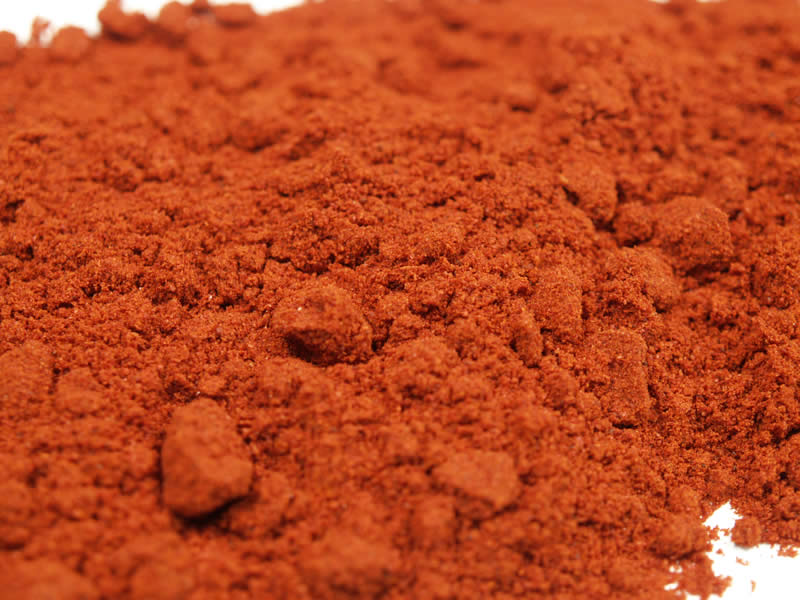Food-Info.net> Food Products > Spices
Paprika (Capsicum annuum L.)
Plant family
Solanaceae (nightshade family related to tomatoes and eggplants)
Botanical synonyms
Capsicum tetragonum
Origin
Paprika is believed to have originated in Southern Mexico. Early Spanish explorers took red pepper seeds to Europe where the plant gradually lost its pungent taste and became sweet paprika. Other species were also first cultivated in Western South America. The peppers migrated to Balkans, Hungary and surrounding areas in the16th century. Some credit for the spread of paprika goes to the invasion of the Ottoman Turks into Central Europe.
A fairly warm climate is, however, necessary for a strong aroma; therefore, in Europe, Hungarian paprika has best reputation. The best comes from the Kalocsa region. In the Unites States, California and Texas are the main producers.
Used plant part
Berry fruits of paprika are used for the culinary purposes.
Paprika is also classified as a chili powder. Chili powder is the dried, ground pods of any or all members of the genus Capsicum. Paprika powder can be either sweet or hot and is prized for its brilliant red colour.

Fresh Chilhuacles negros (Source)
Sensoric quality
Sweet and aromatic. Some varieties show no pungency at all, others are fairly hot.
Mostly, paprika has a pleasantly fragrant aroma. The flavour ranges from sweet and mild to pungent and fiery. This is partly based on the processing of the peppers. The pungency of the ground paprika depends on whether or not the seeds and the stems are ground with the dried peppers. It is usually said that the redder the colour, the milder the paprika. Conversely, the more yellow the colour, the stronger the flavour.
Main constituents
The principal compound for the pungency is capsaicin and related capsaicinoids. In ‘mild' peppers it is as low as 0.001 to 0.005% and in ‘hot' it is up to a level of 0.1%.
The chemical composition of the Capsicum species includes a fixed oil, capsaicinoids, volatile oil and carotenoid pigments mostly capsanthins.
Apart from capsaicin, the taste of paprika is mostly due to its essential oil. The scent of paprika is due to a range of alkylmethoxypyrazines.
Ripe paprika contains about 6% sugar and 0.1% of vitamin C.
Paprikas derive their colour in the ripe state mainly from carotenoid pigments, which range from bright red (capsanthine, capsorubin and others) to yellow (cucubitene). Total carotenoid content in dried paprika is about 0.1 to 0.5%. Some varieties of paprika contain pigments of anthocyanin type and develop dark purple, aubergine-coloured or black pods in the last stages of ripening. However, in some Capsicum varieties, anthocyanin production is a rare phenomenon.

Paprika powder (Source)
Use
Paprika is often eaten as ground powder as a spice but sometimes also as a fresh vegetable. It is a common ingredient in Hungarian, Balkan, Middle Eastern and Central Asian cuisines. In Spain, Germany, Hungary, Central Europe and Turkey, paprika is used for sausage preparation and mixed with meats and other spices including Spanish chorizos. Many Spanish, Portuguese and Turkish recipes use paprika for soups, stews, casseroles and vegetables. Goulash and chicken paprikash are famous dishes with paprika in Hungary. In USA it is often a garnish on stuffed eggs, fish and cheese and vegetable casseroles. In India paprika is used in tandoori chicken, stuffed paprika and for many cuisines for flavour or as vegetable. In Morocco, it is used in tomato dishes and salads. Chili powder from paprika is used in cuisines of Mexico, Guatemala, Honduras, Panama, Costa Rica, South America and the Caribbean as well as the USA.
Paprika is an emulsifier, temporarily bonding with oil and vinegar to make a smooth mixture for salad dressing. It spices and colours cheese and cheese spreads marinades, smoked foods, chicken and other meats, shellfish, rice and almost any savoury dish. It can be combined with butter, margarine or oil to improve the taste for fish, poultry or turkey.
It is important to remember that paprika has high sugar content (about 6 %) and burns easily. It releases its colour and flavour when heated. Thus sprinkling ground paprika over colourless dishes improves their appearance, but adds little to the flavour. In Hungary, this is called ‘A feast for the eyes ' and is used as a garnish and not as flavouring.
Source : www-ang.kfunigraz.ac.at/~katzer/engl/spice_welcome.html




